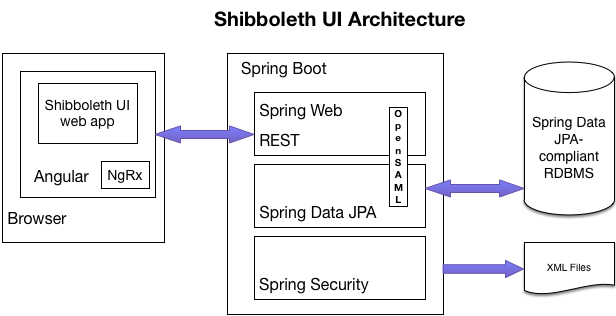Click to see the overview fact sheetView file name shibui_jw_15.pdf height 250
Project Resources Wiki
Project Overview
A GUI (Graphical User Interface) is being developed for the Shibboleth IdP, funded by Internet2/Trust and Identity and Unicon and with the guidance of community architects including Scott Cantor, whose initial focus is on managing metadata and metadata filters (using entity attributes). This Shibboleth Metadata Management GUI will be referred to below as the Shibboleth UI for short.
...
Further iterations of the Shibboleth UI are planned, which will continue to expand on the range of metadata provider and filter types supported thru the UI, and allow defining and managing custom entity attributes. How the UI expands beyond that is a conversation for the community to have as this work moves forward.
Architecture
The Shibboleth UI is written as a Spring Boot application, with Angular used for the front-end (UI). And it relies on a persistent relational database for storing the configuration data created through the UI, and then writes out XML files to disk. The XML files include the individual metadata sources (files) being managed through the UI, which by default will be written into a generated/ directory with filenames of the SHA1 hash of the entityId. And it will write out a metadata-providers.xml file that contains all metadata providers defined through the UI, along with any filters that have been created for of those metadata providers.
Assumptions
The Shibboleth UI is specifically written to work with new metadata-driven configuration support that Shibboleth Identity Provider 3.4 has introduced. So the assumption is that you will use the Shibboleth UI in conjunction with IdP 3.4. And that the underlying configuration of your Shibboleth IdP 3.4 instance(s) will have been modified to activate metadata-driven configuration support, include the needed LocalDynamic metadata provider definition and metadata/generated directory (for the individual metadata sources (files) managed through the UI) etc. If you use the TIER-provided Docker Shibboleth Identity Provider 3.4 package, these IdP configuration changes will have already been made.
If you are not going to use the TIER Shibboleth IdP 3.4.x Docker distribution, then you would need to make these IdP 3.4.x configuration changes yourself. The following page discusses the range of changes that are needed to take full advantage of this Shibboleth UI.
Deployment
There is a TIER Docker Shibboleth UI testbed deployment one can use, that provides the full environment one needs to explore and gain experience with the Shibboleth UI. This Dockerized testbed version is available at https://github.internet2.edu/docker/shib-ui . That testbed follows the TIER packaging guidelines. It relies on supervisord, and includes the Shibboleth UI, a Shibboleth IdP (with a shared filesystem between the Shibboleth UI and Shibboleth IdP), an LDAP server as the base credential/attribute store for the IdP, the TIER Maria DB image for the UI's persistent database, and the TIER Beacon configuration.
Beyond becoming familiar with the Shibboleth UI by using the testbed, note that the Shibboleth UI has been built to be deployed as its own web app. It would run in the same servlet engine as the IdP, or it could run in a separate one. The key link is that files generated by the UI need to end up making it into the IdP's configuration (conf/) directory, however you want to make that happen. That could be a NFS/SMB file sharing approach, it could be rsync or scp or something similar, or you could put the files into a repo and then pull out of the repo into the IdP.
Documentation
The latest documentation, including the top-level README included below, can be found in the TIER Shibboleth Ui code repository, primarily in its docs/ directory. And for deployment using the TIER Packaging (Docker container) and a testbed environment (as noted in the above Deployment section), see the documentation in the TIER Docker Container Packaging for Shibboleth UI repository,
...
- Getting Started
- Default Properties
- Database Configuration
- Metadata Sources (individual one-entityID-per files)
- Metadata Providers
- Customizations and Custom Development
- Internationalization Guide
Internet2 Shibboleth UI Repositories
- TIER Shibboleth Ui code repository
- TIER Docker Container Packaging for Shibboleth UI
Here is the top-level README from the TIER Shibboleth Ui code repository. Note that to be sure you are viewing the latest such version of it, you should go to the TIER Shibboleth Ui code repository linked to above.
| Info | ||||||||
|---|---|---|---|---|---|---|---|---|
shibuiFor more information, see Requirements
RunningThere are currently 2 ways to run the application:
Note that some features require encoded slashes in the URL. In tomcat (which is embedded in the war), this can be allowed with:
In Apache HTTPD, you'll need something like:
Running as an executable
For complete information on overriding default configuration, see [https://docs.spring.io/spring-boot/docs/current/reference/html/boot-features-external-config.html]. Deploying as a WARThe application can be deployed as a WAR file in a Java Servlet 3.0 container. Currently, the application must be run in the root context. To override default configuration, see [https://docs.spring.io/spring-boot/docs/current/reference/html/boot-features-external-config.html]. The easiest way to do this in a servlet container is through the use of system properties AuthenticationCurrently, the application is wired with very simple authentication. A password for the user
Default PropertiesThis is a reflection of the default
|
| Code Block |
|---|
Additional resources
Shibboleth Metadata Management GUI - Requirements
...
